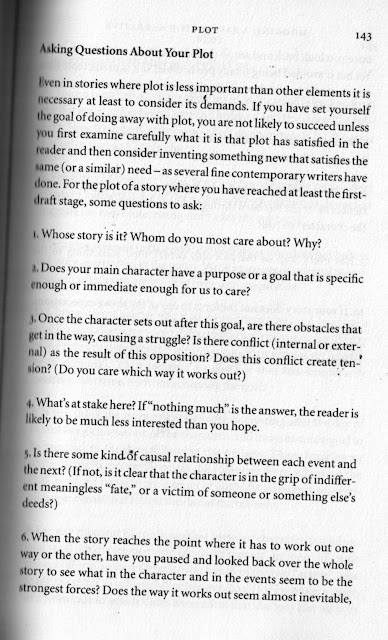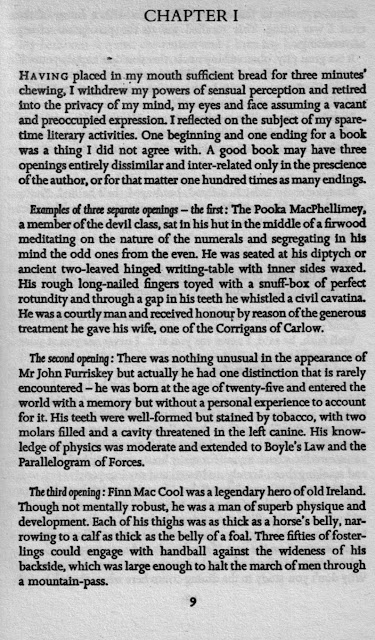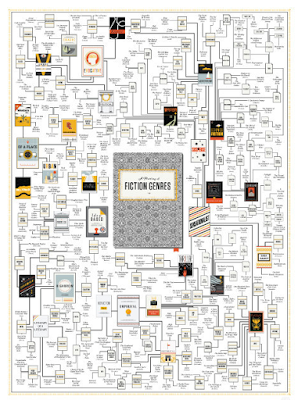25 WAYS TO PLOT, PLAN AND PREP YOUR STORY
from terrible minds
http://terribleminds.com/ramble/2011/09/14/25-ways-to-plot-plan-and-prep-your-story/
by Chuck Wendig (novelist, screenwriter, and game designer)
1. THE BASIC VANILLA TRIED-AND-TRUE OUTLINE
The basic and essential outline. Numbers, Roman numerals, letters. Items in order. Separated out by section if need be (say, Act I, Act II, Act III). Easy-peazy Lyme-diseasey.
2. THE REVERSE OUTLINE
Start at the end, instead. Write it down. “Sir Pimdrip Chicory of Bath slays the dragon-badger, but not before the dragon-badger bites the head off Chicory’s one true love, Lady Miss Wermathette Kildare of the Manchester Kildares.” Rewind the clock. Reverse the gears. Find out how you build to that.
3. TENTPOLE MOMENTS
A story in your head may require certain keystone events to be part of the plot. “Betty-Sue must get sucked into the time portal outside Schenectady, because that’s why her ex-boyfriend Booboo begins to build a time machine in earnest which will accidentally unravel space-and-time.” You might have five, maybe ten of these. Write them down. These are the elements that, were they not included, the plot would fall down (like a tent without its poles). The narrative space between the tentpoles is uncharted territory.
4. BEGINNING, MIDDLE, END
Write three paragraphs, each detailing the rough three acts found in every story: the inciting incident and outcome of the beginning (Act I), the escalation and conflict in the middle (Act II), the climactic culmination of events and the ease-down denoument of the end (Act III). You can, if you want, choose the elemental changes-in-state you might find at the end of each act, too — the pivot point on which the story shifts. This document probably isn’t more than a page’s worth of wordsmithy. Simple and elegant.
5. A SERIES OF SEQUENCES
The saying goes that an average screenplay usually offers up eight or nine sequences (a sequence being a series of scenes that add together to form common narrative purpose, like, say, the Attack On The Death Star sequence from Star Wars). So, chart the sequences that will go into your screenplay. If you’re writing prose, I don’t know how many sequences a novel should have — more than a film, probably (or alternately, each sequence is granted a greater conglomeration of scenes).
6. CHAPTER-BY-CHAPTER
For novel writers, you can chart your story by its chapters. A standard outline is more about dictating plot and story without marrying oneself to narrative structure. This, however, puts the ring on that finger and locks it down tight. A chapter-by-chapter outline is visualizing the reader’s way through the novel.
7. BEAT SHEET
This one’s for you real granular-types, the ones who want to count each grain of sand on your story’s beach. Chart each beat of the story in every scene. This is you writing the entire story’s plot out, but you’re writing it without much dialogue or narrative flair. It’s you laying out all the pieces. The order-of-operations made plain.
8. MIND-MAPS
Happy blocks and bubbles connected to winding bendy spokes connected to a central topical hub. Behold: example. You can use a mind-map to chart… well, anything your mind so desires. It is, after all, a map of said mind. Sequence of events? Character arcs? Exploration of theme? Story-world ideas? Family trees? The crazy hats worn by your villains? Catchphrases? Your inchoate rage and shame made manifest? Your call.
9. ZERO DRAFT
AKA, “The Vomit Draft.” Puke up the story. Just yarf it up — bleaaarrghsputter. A big ol’ Technicolor yawn. You aren’t aiming for structure. Aren’t aiming for art or even craft. This is just you getting everything onto the page so that it’s out there and can now be cleaned up. You’ve puked up the story, now it’s time to form it into little idols and totems — the heretic statuaries of your story.
10. IN THE DOCUMENT, AS YOU GO
AKA, “The Bring Your Flashlight” technique. You outline only as you go. Write a scene or chapter. Roughly sketch the next. Then write it. Onward and upward until you’ve got a proper story.
11. WRITE A SCRIPT
For those of you writing scripts, this sounds absurd. “He wants me to outline my script by writing a script? Has this guy been licking colorful toads?” Sorry, screenwriters — this one ain’t for you. Novelists, however, will find use in writing a script to get them through the plotting. Scripts are lean and mean: description, dialogue, description, dialogue. It’ll get you through the story fast — then you translate into prose.
12. DIALOGUE PASS
Let the characters talk, and nothing else. Put those squirrely fuckers in a room, lock the door, and let the story unfold. It won’t stay that way, of course. You’ll need to add… well, all the meat to the bones. But it’s a good way to put the characters forward and find their voice and discover their stories. Remember: dialogue reads fast and so it tends to write fast, too. Dialogue is like Astroglide: it lubricates the tale.
13. CHARACTER ARCS
Characters often have arcs — they start at A, go to B, end at C (with added steps if you’re feeling particularly saucy). Commander Jim starts at “gruff and loyal soldier boy in the war against the Ant People” (A) and heads to “is crippled and betrayed by his country, left to die in the distant hills of the Ant Planet” (B) and ends up at “falls in love with a young Ant Maiden and he must fight to protect his ant-man larvae” (C). A character arc can track plotty bits, emotional shifts, outfit changes, whatever.
14. SYNOPSIS FIRST
You might think to write your query letter, treatment or synopsis last. Bzzt. Wrong move, donkeyface. Write it up front. It’s not etched in stone, but it’ll give you a good idea of how to stay on target with this story.
15. INDEX CARDS
Index cards are a kick-ass organization tool. You can use them to do anything — list characters, track scenes, list chapters, identify emotional shifts, make little Origami throwing stars that will give your neighbors wicked-ass paper-cuts. Lay them on a table or pin ‘em to a corkboard. Might I recommend John August’s “10 Hints For Index Cards?” I might, rabbit. I might. See also: the Index Card app for iOS.
16. WHITEBOARD
A whiteboard represents a great thinking space. Notes, mind-maps, character sketches, drawings of weird alien penises. Get some different color pens, chart your story in whatever way feels most appropriate.
17. THE CRAZY PERSON’S NOTEBOOK
Once in a while a story of mine demands a hyper-psycho notebook experience. My handwriting is messier than a garbage disposal choked with hair, but even still, sometimes I just like to put pen to paper and scribble. And I sometimes print stuff out, chop it up, and tape it into the notebook.
18. COLLAGE
You’re like, “What’s next? A shoebox diorama of the Lincoln assassination?” That’s a different blog post. Seriously, on my YA-cornpunk novel POPCORN, I took a whole corkboard and covered it in images and quotes that were relevant to the work. Then I’d just wander over there from time to time, stare at it, get my head around the story I’m telling and the feel of the world the story portrays. Surprisingly helpful.
19. SPREADSHEETS
Stare too long into the grid of a spreadsheet and you will feel your soul entangled there — a dolphin caught in a tuna net. Even still, you may find a spreadsheet very helpful. Track plots and beats to your heart’s delight. Seen JK Rowling’s spreadsheet for Harry Potter?
20. STORY BIBLE
Everything and anything goes into the story bible. Worldbuilding. Character descriptions. The “rules” of the story. Plot. Theme. Mood. An IKEA furniture manual. (Goddamn Allen wrenches.) The BIOSHOCK story bible was reputedly a 400+ page beast, which means that yes, your story bible may be bigger than your actual novel. The key is not to let this — or any planning technique — become an exercise in procrastination. You plan. Then you do. That’s the only way this works.
21. THE POWER OF TEMPLATES
Film and TV scripts already follow a fairly rigorous template, but you can go further afield. Look to Blake Snyder’s SAVE THE CAT beats. Or Joseph Campbell’s hero’s journey. Go weirder with the Proppian morphology of fairy tales. You may think it non-imaginative but the power of art and story lives easily within such borders as it does outside of them.
22. STREAM OF CONSCIOUSNESS STORY BABBLE
Slap on a diving bell and jump deep into the waters of the stream of consciousness. Order, you see, is sometimes born first from chaos, wriggling free from a uterus made from fractal swirls and Kamikaze squirrels. Open yourself to All The Frequencies: get into your word processor or find a blank notebook page and just scribble wantonly without regard to sense or quality. You may find your story lives in the noise and madness and that on that snowy screen you will find structure. Like a Magic Eye painting that reveals the image of a dolphin riding a motorbike and shooting Japanese whalers with twin chattering Uzis.
23. VISUAL STORYBOARDS
Sometimes the words only come when given the bolstered boost of a visual hook. Sketch it out yourself. Get an artist friend. Find images from the Internet. Ingest some kind of dew-slick jungle mushroom and paint your story on the wall in an array of bodily fluids. Sometimes you really need to visualize the story.
24. THE TEST DRIVE
Take your characters, storyworld and ideas, and run them through a totally separate story. Let’s call it apocryphal, or “non-canonical.” It’s not a story you intend to keep. Not a story you want to publish. You’re just taking your story elements through their paces. Run them around a test drive. “This is where Detective Shirtless McGoggins solves the murder of the goblin seamstress.” Sure, your Detective lives in the real world, a world not populated by goblins. Fuck it, it’s just an exercise. A test run to find his voice and yours.
25. PANTS THE HELL OUT OF IT
All this plotting and scheming just isn’t working for you, so go ahead and pants the hell out of it. (Me? I don’t wear pants. Pants are the first tool of your oppressors.) Sometimes trying to wrestle your story into even the biggest box is just an exercise in frustration, so do what works for you and what doesn’t. Once again, however, I’ll exhort you to at least learn the skill of outlining — because eventually, someone’s going to ask for a demonstration of your ability.














